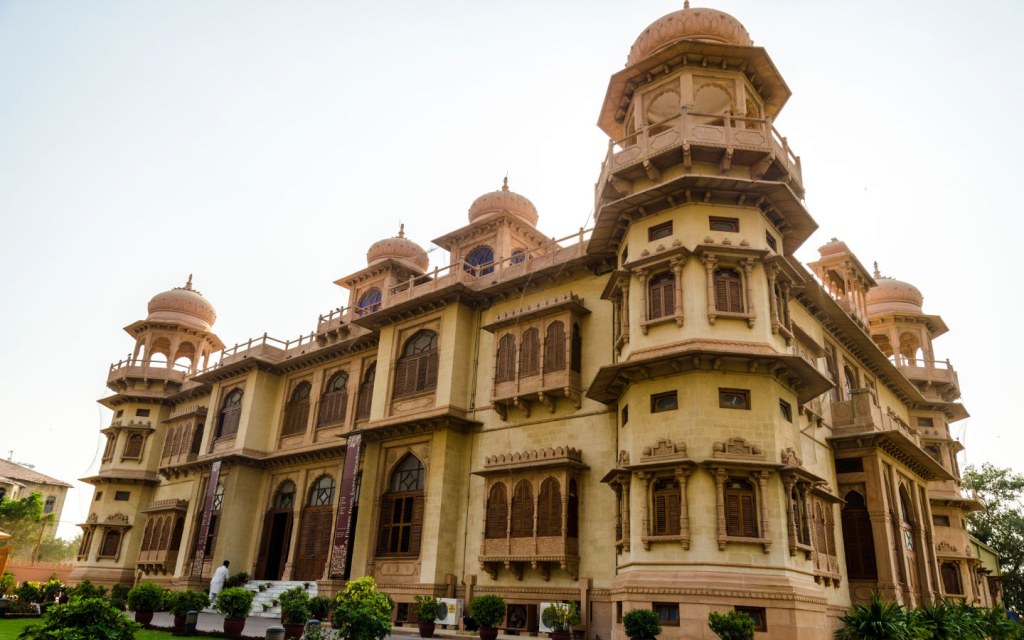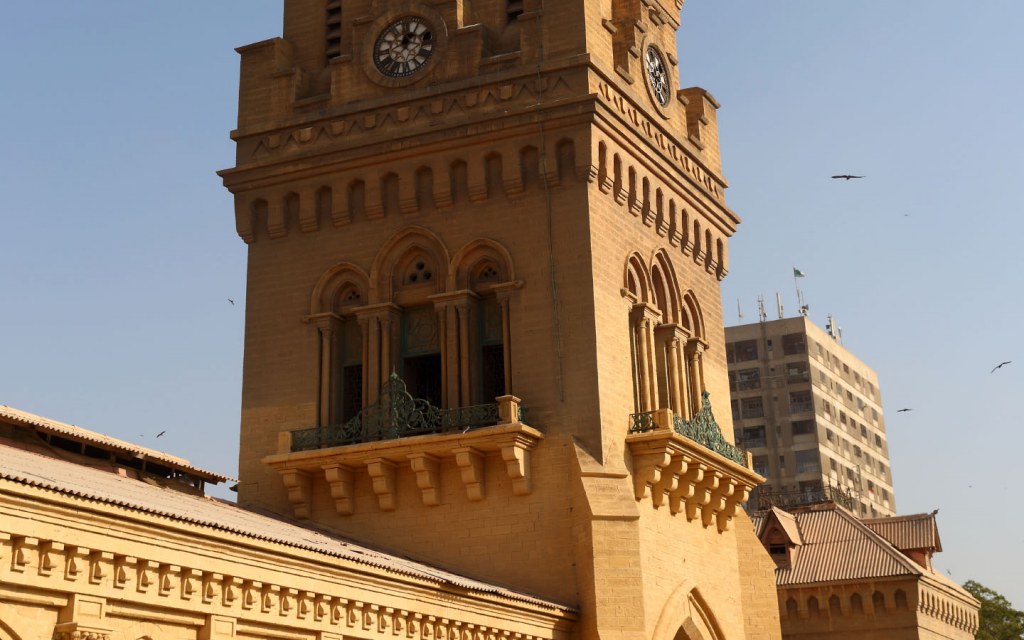Karachi, founded in 1729 as a port settlement, became the seat of culture, when the British conquered Sindh in 1843. During pre-partition days, many buildings with colonial-style architecture, such as churches, educational institutes and libraries were constructed. To this day, there are many historical buildings in Karachi, reflecting their glorious past. If you are a history buff who plans to visit the city soon, then make sure to visit the spots mentioned in this piece.
Top 5 Historical Buildings in Karachi
Karachi has a number of buildings with great historical significance. Many were built over a century ago, but they haven’t lost their original splendour. Some of the most famous buildings in Karachi are as follows:
- Mohatta Palace Museum
- Khaliqdeena Hall
- Denso Hall
- Empress Market
- Karachi Port Trust Building
Let’s look at each one of them in detail.
Mohatta Palace Museum

Mohatta Palace is a museum located in Clifton. Shivratan Chandraratan Mohatta, a Hindu businessman, had constructed it in 1927. Mohatta Palace was built by Agha Ahmed Hussain. Inspired by the stone palaces in Rajasthan, it has beautiful pink Jodhpur stones – an integral part of its architectural design. It is a double-storeyed structure that spans an area of 18,000 square feet. When you enter the Palace, you will first notice coloured windows, a stone wall, four minarets, an arch and a spectacular view of architectural splendour. The roof-top contains a magnificent structure having a central dome that is surrounded by smaller ones. The four minarets and the central dome not only add grandeur to the building, but were specifically built to protect residents from the scorching heat of direct sunlight. It also qualifies to be one of the best photo shoot locations in Karachi.
Historical Significance
A must-visit historical building in Karachi, Mohatta Palace has an interesting backstory. It is believed that one of the major reasons to construct this building was a serious illness contracted by Mohatta’s wife. The doctors had informed Mohatta to live by the sea as the refreshing winds only could cure her. Mohatta, then, built this fascinating bungalow in Clifton, covering a large area. The family lived in the palace for nearly two decades before migrating to India after partition. After Pakistan came into being, Mohatta Palace was given to Fatima Jinnah, Quaid-e-Azam’s sister, who also took part in politics with her brother.
Fatima Jinnah’s political campaign against dictator Ayub Khan also began from the Mohatta Palace. She breathed her last in the same building. After she passed away, there was a family dispute over who should own Mohatta Palace. It was given to Shireen Jinnah by the High Court. But when she passed away in 1980, the Government of Sindh took control of the building and restored to its original state, bringing back its lost grandeur. Interestingly, the original name of the Palace was Qasr-e-Fatima. However, no one knows it by the name.
Khaliqdeena Hall
Among popular buildings in Karachi is Khaliqdeena Hall. Its original name Ghulam Hussain Khaliqdeena Hall and Library is still written on the facade of the stone building. Inspired from Greek architecture, the building is one of the most important landmarks of Karachi. The pediment, the Ionic portico, the high-ceilings and stylish doors and windows all contribute towards its magnificence. Khaliqdeena Hall was constructed in 1906. The building was named after Ghulam Hussain Khaliqdeena as he had given a donation of around PKR 18,000, which was considered a huge amount back then. Around 600 people can be seated in the main hall. It also has a library. It is located on main M.A Jinnah Road.
Historical Significance
Behind Khaliqdeena Hall’s beautiful architecture is a story that holds great historical significance. In 1921, Khaliqdeena Hall was used as a courtroom. The Hall was chosen by the British authorities for the trial of leaders of the Khilafat movement, Maulana Mohammad Ali Jauhar and Maulana Shaukat Ali. They were charged for mutiny against the British government.
Empress Market

Empress Market is a huge marketplace located in the heart of Saddar Town. There is a clock tower surrounded by a courtyard. There are a number of shops selling spices, fresh meat, hand-pressed oils and what not. It is one of the most-visited historical buildings in Karachi, as people come here to buy things at affordable rates.
Historical Significance
The Empress Market was built by James Strachan in the years 1884-1889 during the British rule. It was built to commemorate Queen Victoria, who was the Empress of India at the time – hence the name. This building has an interesting yet a sad tale. Empress Market was built on a site where a number of sepoys of the British Army were executed in a horrific way. They were brought in the ground and shot with huge cannonballs. This was done right after the Sepoy Mutiny in 1875. The British government feared that the locals would create a monument on the site of the massacre to honour the sepoys who laid their lives in the quest for freedom. To avoid this happening, the government constructed a building to commemorate the Empress of India.
Denso Hall
Denso Hall was a library built by the British government. The architect of the building was James Strachan who completed the project in 1886. It has a gothic-style architecture and design. The building is made of sandstone. A cultural heritage site, Denso Hall is a neglected edifice, but, once restored, would be one of the best historical buildings of Karachi. There is a library, a reading room on the ground floor and a big hall on the first floor.
Historical Significance
Karachi was only a small port settlement during the rule of Talpurs in Sindh. When the British East India Company entered Karachi, the British gauged the city’s importance. The British laid the foundations of a city, government was formed and infrastructural developments took place. There were numerous libraries built by the British government, however those libraries were only meant for government officers and families only. Denso Hall constructed in 1886, was the first library meant for the local people.
Karachi Port Trust Building
Karachi Port Trust is a federal government office that overlooks the operations at the port of Karachi. From 1880-1887 it was under Karachi Harbour Board. Karachi Port Trust (KPT) was later established through the Act IV – 1886. KPT’s office is located in KPT building. The first glimpse of the building takes you to the renaissance period of the British Raj. It is located on the opposite side of Eduljee Dinshaw Road in Karachi. Spread over 1400 square meters of land KPT office building also has an interesting historical reference behind it.
Historical Significance and Architecture
During the First World War (1914-1918), there were many make-shift hospitals that served the injured. At the time, KPT building was also converted into a 500 bed hospital. The colour of the building is a combination of green and yellow. The building is stone-based and in the center is a large dome placed at the top. Domes have always been a key feature in Roman architecture. The windows, doors and archways are green in colour and show signs of Gothic and Roman style architecture.
These were some of the most famous historical places in Karachi with an interesting story. If you are interested in reading more about historical buildings in different cities, you can check out our blog on famous buildings in Lahore.
And if you are visiting the city of lights for the first time, then you should read all the things you can do in Karachi in a day. For more of such updates and historical facts about buildings in different cities, stay tuned to Zameen, the best lifestyle blog in Pakistan.



